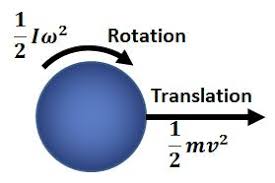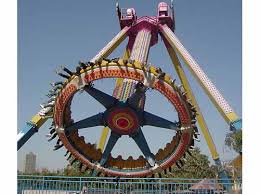Rotational Kinetic Energy
Just as moving objects have kinetic energy due to their linear motion, rotating objects have rotational kinetic energy due to their spinning motion. This energy depends on both how much mass is distributed away from the axis (moment of inertia) and how fast the object is spinning (angular velocity).
- $K_{\text{rot}}$: Rotational kinetic energy (Joules, J)
- $I$: Moment of inertia (kg·m²)
- $\omega$: Angular velocity (rad/s)

Interactive Simulation: Spinning Circle
Explore how radius, mass, and angular velocity affect rotational kinetic energy with this interactive simulation.
Moment of Inertia (I): 6.0 kg·m²
Rotational Kinetic Energy: 12.0 J
Physical Meaning
The more mass an object has, and the farther that mass is from the axis of rotation, the greater its moment of inertia. The faster it spins, the more rotational kinetic energy it has. This is why a spinning flywheel or a rotating planet stores a lot of energy.

Compare: Linear vs. Rotational Kinetic Energy
| Linear | Rotational |
|---|---|
| $K = \frac{1}{2}mv^2$ | $K_{\text{rot}} = \frac{1}{2}I\omega^2$ |
| Mass ($m$) | Moment of inertia ($I$) |
| Speed ($v$) | Angular speed ($\omega$) |
| Translational motion | Rotational motion |
Example 1: Rotational Kinetic Energy of a Spinning Disk
A solid disk of mass $2\,\text{kg}$ and radius $0.5\,\text{m}$ spins at $10\,\text{rad/s}$. What is its rotational kinetic energy?
Solution:
Moment of inertia for a solid disk: $I = \frac{1}{2}MR^2$
$I = \frac{1}{2} \times 2 \times (0.5)^2 = 0.25\,\text{kg} \cdot \text{m}^2$
$K_{\text{rot}} = \frac{1}{2} \times 0.25 \times (10)^2 = 12.5\,\text{J}$
Example 2: Comparing Two Objects
A solid sphere and a thin hoop both have mass $1\,\text{kg}$ and radius $0.4\,\text{m}$, spinning at $5\,\text{rad/s}$. Which has more rotational kinetic energy?
Solution:
For the sphere: $I_{\text{sphere}} = \frac{2}{5}MR^2 = \frac{2}{5} \times 1 \times (0.4)^2 = 0.064\,\text{kg} \cdot \text{m}^2$
$K_{\text{rot, sphere}} = \frac{1}{2} \times 0.064 \times 25 = 0.8\,\text{J}$
For the hoop: $I_{\text{hoop}} = MR^2 = 1 \times (0.4)^2 = 0.16\,\text{kg} \cdot \text{m}^2$
$K_{\text{rot, hoop}} = \frac{1}{2} \times 0.16 \times 25 = 2.0\,\text{J}$
Conclusion: The hoop stores more rotational kinetic energy because its mass is farther from the axis.
Real-World Applications
- Flywheels: Used in engines and energy storage to maintain steady rotation and store energy.
- Figure Skaters: Pulling in arms reduces $I$ and increases $\omega$, but $K_{\text{rot}}$ can change if work is done.
- Planets and Stars: Rotational kinetic energy is a major part of their total energy budget.
- Amusement Park Rides: Rotating rides use and dissipate large amounts of rotational kinetic energy.

Summary / Takeaways
- Rotational kinetic energy is stored in spinning objects.
- It depends on both the moment of inertia and the square of angular velocity.
- Objects with more mass farther from the axis (higher $I$) store more energy for the same $\omega$.
- This concept is crucial in engineering (flywheels, turbines), astronomy (planets, stars), and everyday life (wheels, gears).
- Comparing $K_{\text{rot}}$ for different shapes shows the importance of mass distribution.